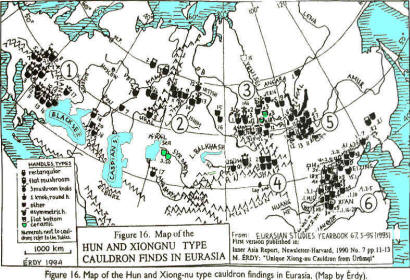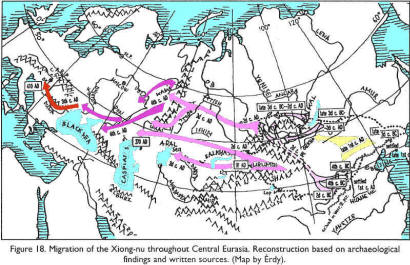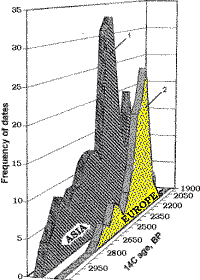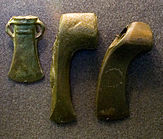
Türkic-lingual Period Of European History
Moscow, Yaroslavl, “Letter", 2011, ISBN 978-5-904729-20-2
Chapter 1.6 Huns (on Cimmerians)

Links
http://books. google. com/books?id=v-vNeNVEMXoC (1st ed. , 2008)
YNDrozdov<oops>yandex. ru
Posting Foreword
The following essay is an extract from the Chapter 1 Scythians, subchapter 6 Huns, focused on Cimmerians, an obscure people mainly known to be the nomadic victims of the nomadic Scythians, whose legacy was carried across Europe and across millenniums. The historical picture was always obscure, complicated by the naming convention that hid subdued people under the name of the ruling people, a tendency that goes unabated to the present. In case of the Slavic Bulgars, written history left enough records to discern the course of the history and the source of their ethnonym, but even for the contemporaneous Ruses, the picture remains cloudy to this day. Much more difficult is the situation with the Cimmerians, who first appeared as precursors of the Scythians, Cimmerians received a notable position in the Hebrew Bible, they are archeologically indistinguishable from the Scythians, but were not immortalized by their contemporaries, and came to be better known at a time after their demise. In a rush to “Indo-Europify” everything and everybody, the 20th c. made the picture even muddier, J. Harmatta attempted to link 3 names in the Assyrian inscriptions with Old Iranian language, ingenuously explaining a divination that Cimmerians had an Old Iranian ruling class. Since the Old Iranian language does not have a word for mounted horse riding, apparently Cimmerians were dragging their ruling class on the supply train carts, while up front their cavalry was assaulting kingdoms and slaughtering uncooperative kings. In the Classical historical literature, Cimmerians were equated with Scythians, which is consistent with the available archeological and ethnological record analyzed by A.Ivanchik (2001), and with Behistun inscription. Cimmerians were a tribe of Scythians.
| Cimmerian archer in Scythian trademark bonnet hat | Cimmerian artifacts | Cimmerians in Biblical account | Cimmerian excursions | Cimmerian excursions |
|---|---|---|---|---|
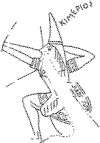 |
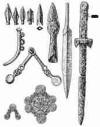 |
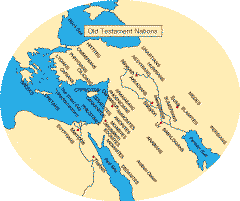 |
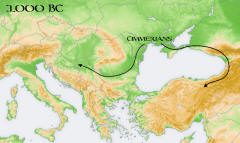 |
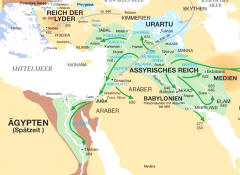 |
The following dateline pretty much summarizes all written records on Cimmerians. Most significant is Behistun inscription, which calls Cimmerians Saka/Scythians.
| DATELINE | |
|---|---|
| Time | Events |
| 1200 BC | Cimmerians mentioned in Homer's Oddysey (11.14), maybe about ca 1250 BC |
| 1000 | ca. 1000 to 700 BC - Cimmerians in Thrace |
| 950 | 9th or 8th century BC - Homer mentioned Cimmerians living on shores of Oceanus at edge of known world, maybe northern shores of Black Sea |
| 900 | ca 900-650 - Cimmerians maybe associated with the pre-Scythian Chernogorovka and Novocherkassk cultures |
| 800 |
8th century BC, Herodotus: Cimmerians in today's Ukraine north of Black Sea. They fled advancing Scythians and moved south across Caucasus. They ended up in today's Azerbaijan within Mannae state |
| 721 | 721-715 BC – Sargon II mentions Gamirr land near Urartu. Sennacherib mentions a land of Gamirr near Urartu |
| 714 | First historical record of Cimmerians called Gimirri in Assyrian annals in today's Azerbaijan, Cimmerians invaded Assyrian lands from so far north. Cimmerians helped Assyrian king Sargon II defeat kingdom of Urartu. Their homeland, called Gamir or Uishdish, is located in Mannae state N. of Assyria |
| 714 | 714-626 BC - Brief period of exiting activity. Cimmerians kill Assyrian king in battle, sack and destroy Phrygia and Lydia |
| 714 | Suicide of Rusas I of Urartu, after defeat by both the Assyrians and Cimmerians |
| 705 | Cimmerians rebelled against Sargon II of Assyria, Sargon ventures on expedition against Kulummu, and died in battle against them. Cimmerians extended eastward from Mannae through Mede settlements in Zagros, and then south to Elam |
| 700 | Scythians displace Cimmerians from Crimea, Cimmerians came to the region around lake Van |
| 700 | Scythians invade Thrace |
| 696 | 696-695 - Cimmerians ravage and conquer Phrygia, prompting Phrygian king Midas to take poison rather than face capture. Cimmerians sack Gordium |
| 695 | Cimmerians destroyed Phrygia. King Midas died |
| 679 | 679/678 – Gimirri under a ruler called Teushpa invade Assyria from Hubuschna (Cappadocia?). Esarhaddon of Assyria defeats them in battle |
| 679 | 679/678 - Cimmerians under their king Teushpa invade and attack Cilicia and Tabal. Assyrian king Esarhaddon defeats Cimmerians in battle near Hubushna (Cappadocia ?) |
| 676 | 676-674 – Cimmerians invade and destroy Phrygia, and reach Paphlagonia |
| 654 | 654 or 652 – Cimmerians attack the kingdom of Lydia, sack of Sardis. King Gyges of Lydia dies in battle against Cimmerians.; Cimmerians and Thracian Treres plunder Ionian Greek colonies in western Asia Minor, Greek poets Callinus and Archilochus recorded fear inspired in Ionian Greek colonies |
| 644 | Cimmerians return to Lydia and capture and occupy Sardis (except citadel) during reign of Gyges' son Ardys II. Cimmerian withdraw soon afterwards, possibly due to outbreak of plague |
| 634 | Scythians invaders in Thrace conquer Cimmerians |
| 637 | 637-626 – Cimmerians beaten back and defeated by Alyattes II of Lydia, marking effective end of Cimmerian power. They do not appear again in Asia. Possibly, Cimmerians eventually settled in Cappadocia, Gamir (Գամիրք, Gamir-kʿ) in Armenian, same as original Cimmerian homeland in Mannae |
| 515 | ca. 515 – Last historical record of Cimmerians, in Darius' Behistun inscription, as Babylonian equivalent of Persian Saka (Scythians) |
| 50 AD | Several Roman authors (Pliny ca 50 AD, Ovid ca 10 AD, etc.) locate Cimmerians near Lake Arverno (since Cimmerians are located at entrance to Hades at shores of Oceanus, and entrance to Hades was near Lake Arverno) |
Page numbers are shown at the beginning of the page. Posting notes and explanations, added to the text of the author are shown in (blue italics)) in parentheses and in blue boxes, or highlighted by blue headers.
| PREFACE | 7 | |
| ÏÐÅÄÈÑËÎÂÈÅ | 12 | |
| Chapter 1 | SCYTHIANS | 17 |
| 1. Tribes of North Black Sea Region and Neighboring Tribes | 26 | |
| 2. Tribes mentioned by Strabon | 39 | |
| 3. Tribes mentioned by Pliny the Elder | 42 | |
| 4. Tribes mentioned by Ptolemy | 51 | |
| 5. Goths | 55 | |
| 6. Huns | 74 | |
| 7. Avars | 93 | |
| Chapter 2 | ENETOI AND WENDS | 100 |
| Chapter 3 | SCLAVENES, ANTES, AND VANDALS | 107 |
| 1. Sclavenes | 107 | |
| 2. Antes | 122 | |
| 3. Vandals | 125 | |
| Chapter 4 | SCANDINAVIAN ETHNIC TERRITORY | 134 |
| Chapter 5 | EASTERN BALTIC REGION | 166 |
| Chapter 6 | GERMANS | 221 |
| Chapter 7 | FRANKS | 236 |
| Chapter 8 | GAUL | 250 |
| Chapter 9 | BRITAIN | 260 |
| Chapter 10 | ITALIAN ETHNIC TERRITORY | 285 |
| Chapter 11 | ‘HELLENE’, ‘GREEK’ AND ‘ROMAN’ ETHNONYMS | 312 |
| Chapter 12 | PEOPLES OF KAMA AND VOLGA RIVERS | 330 |
| 1. Ruses | 331 | |
| 2. Magars | 356 | |
| 3. As-Saqaliba | 387 | |
| 4. Cheremises | 396 | |
| 5. Chuvashes | 400 | |
| 6. Bulgars | 408 | |
| 7. Burtas | 426 | |
| 8. Khazars | 430 | |
| Chapter 13 | RUSSIAN ETHNIC TERRITORY | 436 |
| 1. Antique Sources | 436 | |
| 2. Ancient Scandinavian Sources | 440 | |
| 3. Russian Chronicle Sources | 445 | |
| 4. Muscovy | 490 | |
| 5. Toponymy | 522 | |
| Chapter 14 | ON CHRISTIANITY | 540 |
| REFERENCES | 567 | |
Türkic-lingual Period Of European History
Chapter 1. SCYTHIANS
Section 6. Huns
Cimmerians (Excerpts)
Initially, Jordan records Huns on the eastern side of the Azov Sea.
The Jordanes' story almost word for word relates his contemporary, a Greek writer Procopius of Caesarea. But his account has a part fundamentally different from Jordan's, he calls the Huns Cimmerians: /76/ “According to them, if this story is correct, once some Cimmerian boys, hunting with hounds, chased a doe; and she fled from them, running into these waters. The boys either for vanity, by passion, or led by some mysterious will of deity, followed the deer and kept up with her, until they reached with her the opposite shore. There the hunted animal (who can say what was it?) immediately disappeared ... but boys, failing in the hunt, discovered a surprising chance for new battles and spoils.
Returning as soon as possible home, they immediately notified all Cimmerians that the waters are quite passable. And then, everybody having grabbed the arms, they crossed without delay the “Swamp” and came to the opposite mainland.” 138 In another place, describing people in the area of the “Meotida swamp” (Meotida, Meotis, Maeotis = Azov Sea, from Azov fort = Tr. As-ev = Ases fort, in turn named after the As tribe), Procopius wrote: “...in antiquity people who live there were called Cimmerians, but now they are called Utigurs. Further north, the land is occupied by countless tribes of Ants.” 139 In a third place he wrote: “In ancient times, a great many Huns, who were then called Cimmerians, occupied places which I recently mentioned, and one king was the head of them all. Once they were ruled by the king who had two sons, one called Utigur, another called Kutrigur. When their father finished the days of his life, they divided power, and each gave his subjects his name. So, still in my time, they were called one Utigurs, the other Kutrigurs.” 140 There, Procopius directly states that in antiquity the Huns were called Cimmerians, and in his time Utigurs and Kutrigurs.
Kutrigurs and Utigurs are not Hunnic-Bulgarian tribes, but eastern and western halves of the
Hunnic-Bulgarian state, the very names stipulate a state organization:
|
||||||||||||||||||||||||
Procopius of Caesarea also mentions a number of tribes who lived not far from the
Hun-Cimmerians: “Spurs of the Caucasian mountains facing north-west reach Illyria
and Thrace, and facing south-east reach the very passages which the Huns tribes use to
reach the land of the Persians and Romans, one of these passages is
called Tzur, and the other has the ancient name of the Caspian gates. Throughout the
country, which stretches from the limits of Caucasus to the Caspian gates, live Alans; they
are an independent tribe, for the most part it was allied with the
Persians, and campaigned against the Romans and other enemies of the Persians.
With this, the story of the Caucasus mountain range I think is complete. There live the Huns,
the so-called Sabirs, and other tribes. It is said that from there came out ... the Amazons.”
141 On the Hunnic tribes located in the North Caucasus, Procopius of Caesarea writes not
too clearly.
77
On one hand, he points out that before the Caucasus passes lived the Huns, who “reach the land of the Persians and Romans”. On the other hand, he notes that the same territory, “which stretches from the limits of Caucasus to the Caspian gates, live Alans”. At the same tribe the Alans “campaigned against the Romans and other enemies of the Persians”. It appears that Procopius of Caesarea holds the North Caucasus Alans as the Hunnic tribes. Somewhere in the same region, he notes Sabirs, also belonging to the Hunnic tribes. As will be shown below, Sabirs is the Türkic name for the Khazars.
Thus, according to these ancient authors, the original Hun territory was located north of the Meotida, toward the Arctic Ocean, near the Ural Mountains. At one time a part of the Hunnic tribes settled in the area from the east coast of the Azov Sea to the western coast of the Caspian Sea. And from there they conducted their raids to the west and south.
A very important factor in the writings of Procopius of Caesarea should be emphasized once again, he directly, clearly, and repeatedly stated that the people living east of Meotida in ancient times were called Cimmerians, and in his time Utigurs and Kutrigurs, and these people belonged to the vast group of the Hun tribes (Hun, not Hunnic, i.e. belonging to the polyethnic Hun confederation). It is unlikely that Ammianus Marcellinus, Philostorgius, Sozomen, Jordanes, and other ancient writers who mentioned Huns were not aware of the fact that the Huns were descendants of Cimmerians. Nevertheless, none of the classical authors, but Procopius of Caesarea, wrote about it. More accurately, the presently known works of these authors do not have such information. Only one explanation of this fact can be given, in the later copying of these authors this information has been removed. The reasons for that until can only be guessed.
So, in the ancient Huns were called Cimmerians
(I.e. relatives of the remote ancestors of the Huns were called
Cimmerians). This people was first mentioned by Homer
in his “Odyssey": “sun went down, and darkness covered all roads, and our ship has
reached the limits of the deep ocean. There's people and city of the Cimmerian people,
surrounded by gloom and clouds, and never the shining sun visits them with its rays,
neither when it rises in the starry heaven, nor when it tips back down from the sky to
earth, but impenetrable night is spread over the miserable mortals”.
142 From that fragment follows that the Homer's Cimmerians lived on the coast, and their territory was constantly covered by fog and
gloom. And
Homer calls this people Cimmerians who have a city. This means that they were not
wild nomads, for the presence of the city shows a certain level of civilization of this
people (Or that at 1150-850 BC, the Greeks and Cimmerians lived
in similar conditions. The “wild nomads” not only lived in dwellings, they had
manufacturing shops for tools and weaponry that they taught Greeks, and educated Greeks
on cheese technology, among other things).
78
The Cimmerians east of Meotida were also mentioned by Herodotus: “...nomadic Scythians in Asia, pressed with war by Massagetae (Masguts), crossed the Aras river and withdrew to the Cimmerian land (indeed, the country occupied now by the Scythians is said to originally belong to Cimmerians)”. 143 From that fragment follows that the Cimmerians were displaced from their territory by one of the Scythian tribes, namely by the nomadic Scythians (Scythians are nomadic by definition, sedentary Scythians are as much Scythians as Iroquois are Yankees). But they displaced not all Cimmerians, but only some of them. Indeed, at the Herodotus time there was preserved the area called Cimmeria, and the Cimmerian walls and Cimmerian crossings, and the Cimmerian Strait (“Scythia still retains traces of the Cimmerians; there are Cimmerian castles, and a Cimmerian ferry, also a tract called Cimmeria, and a Cimmerian Bosphorus” [Herodotus, 4.12]). Actually, it is also confirmed by Procopius of Caesarea when he pointed out that in his time Cimmerians lived off Meotida and being a Hun tribe, were called Utrigurs (I.e. belonged to the eastern/left wing of the state, which included a coalition of ten tribes, or Onogur in Türkic). Moreover, Herodotus stated that the Cimmerians lived on the southern Black Sea coast, near the city of Sinope (42°N 35°E): “Cimmerians, apparently after escaping to Asia from the Scythians, settled on the peninsula where today stands the Hellenic city Sinope”. 144
Strabo noted that
the ethnic name 'Cimmerians' had a synonym - 'Cimvri': “Posidonius ... not badly proposes that
the Cimvri, being robbers and nomads, even campaigned to places by Meotida, and that the
Cimmerian Bosporus received its name after them, i.e. something like Cimbrian, because the Hellens called the Cimvri Cimmerians...”
145 In this statement attention is drawn to two points. Firstly, the 'Cimmerians' is the Greek
version of the name Cimvri. Secondly, Posidonius 'not badly proposes' that the Baltic Cimvri might
have migrated from the Baltic to Meotida. It is quite clear that in geographical terms (and only
geographical) the ancient writers regarded these Cimvri as Germanic tribes, as was noted by
Strabo: “As for the Germans, then as I said before, the northern Germans inhabit the
ocean coast. We know, however, only those tribes that live from the mouth of Rhine to the
Albion;
of these tribes are most known Sugambri and Cimvri.” 146
Diodorus Siculus also noted the synonymy of the ethnic names
'Cimmerians' and 'Cimvri': “The inhabitants of the northern
countries neighboring with Scythia are very wild, it is said that some of them eat people ...
Because their strength and savagery became famous everywhere, some say that these people
under the name of Cimmerians in ancient times went with war across the whole of Asia, and
the time deformed this word into the name of Cimvri...”
147 From the Pliny's description
of the Baltic Sea southern coast follows that Cimbri also inhabited the Jutland Peninsula: “... that the bay
is called Kalipen and the island in its mouth
is Latris, then another bay is Lang, bordering with Cimbri”. 148
Here, Pliny
gives a different phonetic variation of this ethnic name, Cimbri. On the fact that Cimbri
lived on the Jutland peninsula, Tacitus wrote quite definitely: “The above-mentioned
protrusion of Germany is occupied by the living by the ocean Cimbri, now small, but once
famous tribe. /79/ Impressive traces of their former glory, the remains
of a huge camp still remain on this and the other coasts, by the size of which even now
can be seen how much power had this nation, how great were its numbers, and how
accurateis the story of
its total relocation”. 149
79
Is interesting the Tacitus' note that the mentioned Cimbri have totally relocated. It can't be excluded that Cimbri may have settled in other regions of the Baltic Sea coast, and were recorded there under the name of the Huns. For example, “In the saga of Tidrek of Bern, the “Gunaland” is located west of Poland and is directly identified with Friesland”. 150 At present, in one of the oldest parts of Europe has remained an endonym for oneof the people consonant with the ethnic name 'Cimvri' or 'Cimbri'. These are the Welsh people in Britain. They still call themselves Cymro. It can't be excluded that they may be the descendants of the Baltic Cimbri.
To reiterate, firstly, the ethnic names 'Cimmerians', 'Cimvri', and 'Cimbri' are synonymous. Secondly, territory of the ancient habitat of these tribes is mostly recorded by ancient authors as coastal, particularly on the coast of the Jutland peninsula and around Meotida coast. Thirdly, the Cimmerians (Cimvri, Cimbri) are the same Huns, more accurately, a number of Hun tribes.
In the writings of several ancient authors the ethnic affiliation of Cimmerians (Cimvri, Cimbri) is stated quite clearly. Thus, Eustathios (Εὐστάθιος, Eustace) in his explanations to the Homer's “Odyssey” wrote: “The Cimmerians, or nomadic Scythians, coming from the western ocean, plundered the temple of Apollo at Delphi. Because of that, the poet vilifies them as living in the darkness.” 151 And again: “Arrian says that the Scythian tribe of Cimmerians, rising from their homeland and hurting everybody along the way, reached Bithynia”. 152 In his comments to Dionysius' “Description of Habitable World”, Eustathios said: “He calls Taurus another mountain, not that eastern Taurus discussed below, b ut the northern part of that Taurus, at the foot of which livs the Scythian tribe of Cimmerians” 153.
Interesting data on Cimbri is in the Kyiv synopsis: “Cimbri have kindredness from the Yapheth's eldest son Gomer, from hin first are called Gomors, in Greek called Cimers or Cimblers, then dubbed Cimri. Multiplied in their clans, some settled in wild fields, some settled by rivers Don and Volga, some over the Buh river, some by the Dnieper, by the Desna, Sosna, by the other rivers, some by the Black Sea, also Ochakov, Crimea, Burrow (Perekop), by lake Meotida; some also settled in Volhynia (Halych, Galicia, Land of Gauls, from Sl. “volya” = “free”), Podolia (Tr. “dala” = “steppe”, Sl. pefix “po” indicates location, Podolia = “Steppe Lands”), Podlachia, Zhmud and Lithuania.
| Cimmerians in Kyiv synopsis (Itil and Don are not shown) | |||
|---|---|---|---|
| Areas of N.Pontic | Podlachia | Zhmud and Lithuania | |
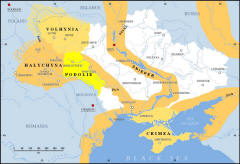 |
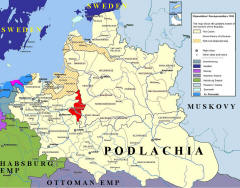 |
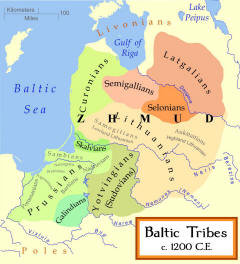 |
|
For from the same Cimri came the Lithuanian people. People from the same Cimri people came at times were named, some Goths, Epids (Gepids/Hepids), others Kipchaks, Yatvyags, and Pechenegs (Bechens). But all those Cimri people are military, brave: and when from midnight countries, most of all now go Lithuania, Pruses, and Swedes, because of their unfertile land have gone to France and Spain, then from there to Volokh (Wallachia? river Wolchow/Volkhov? lake Wolok/Volok?), or to the Romans; Romans did not want to give them land land, they fought numerously with the Romans, many times defeated Romans, and their own villages expanded, and govern as they want. Later on, quieted down, and grown lazy to military affairs, were suddenly defeated by some Roman leader, named Maria, were mercilessly beaten; weakened by that in their strength, Cimbri returned to their midnight country and settled in different places and countries by the above rivers. They split by faith, some are Christians, others remain pagans.” 154 Judging by this message, this source understood under Cimbri all ancient European Türkic peoples.
On the name 'Cimbri' can be noted the following. The Greek transcription of the name of these people is Κίμβροι, Κύμβροι ('Kimbri'), and the Latin is Cimbri (With dialectal C = K or TS). According to the source, the Cimbri genealogy goes back to Gomer, the eldest son of Yapheth. The name of this son is associated with the name of the biblical city Gomorrah, which was located in Jordan and was incinerated, according to legend, by the Almighty for the sins of its inhabitants. Assuming that biblical stories have some real basis (and this seems to be so), the territory of Jordan could be a historic ancestral home of the Cimbri ancestors. It is easy to see that listed in the synopsis places of Cimbri settlement are mostly ethnic territory in Russia populated by ancient Scythian tribes. As descendants of Cimbri are listed only the Türkic tribes of Goths Gepids, Kipchaks, Yatvyags, and Pechenegs (Bechens). The initial territory, from which Cimbri began migrating into the Western Europe and then to Rome, was the Eastern Baltic. And in the list of the Baltic peoples ("Lithuania, Pruses, and Swedes") the 'Swedes' are included clearly by the 'diligence' of the interpreters, instead of the Swedes there should obviously be stated Sweons, the inhabitants of the island Saaremaa. Generally, the information of the synopsis is sufficiently adequate to the similar data from other written sources.
Thus, the Cimmerians (Cimvri, Cimbri) belonged to the Scythian,
i.e. Türkic
people. It is true that Herodotus stated that Cimmerians were displaced from their territory
by the
nomadic Scythians, appearing that they were two different people. However, it
should be noted that only Herodotus calls Scythians the limited circle of the
Black Sea As tribes. /81/ Other ancient writers
applied the ethnic name Scythians to all
As tribes, to which also belonged the Cimmerians.
81
The Cimmerians' belonging to the Türkic people is reliably confirmed by their ethnonym. The root of the ethnic name 'Cimmerian' is a formant 'Kimmer'. From the standpoint of the Türkic language, it can be parsed into its component parts as follows: kim-mer. The first component kim is an ancient Türkic word kimi 'boat, ship'. The second component mer is a somewhat distorted form of the word mar, which is a phonetic version of the word bar 'is, is there'. The original name was Kimbar/Kimmar with a literal translation of 'having boats' or 'having ships'. In another phonetic version of this ethnic name, 'Cimbri', the root formants is 'Kimbr'. It can be parsed into its component parts as follows: kim-br. The first component kim is, as in the previous case, the root base of the ancient word kimi 'boat, ship' and the second component the br is the word bar 'is, is there' without vowels. The original version of this ethnic name, as in the previous case, is Kimbar. In the version 'Kimvri' of the name, the second part of this ethnic name br is a phonetic non-vowelized version of the word bar 'is, is there'.
The modern history defines the Cimmerian territory in Eastern Europe and their ethnicity as follows: “A known
from the historical sources Cimmerian people is identified with
the carriers of the Late Timber Grave archaeological culture in two of its final stages,
Chernogolov and Novocherkassk (9th - middle of 8th c. BC). They were nomadic, most
likely Iranian-speaking tribes, occupying a wide space of the steppes of south Eastern Europe
from the Dniester - Danube interfluvial to the shore of the Kerch
Strait, which after them received the name of Cimmerian Bosporus.”
155 As for the
Iranian-lingual Cimmerians, it is again given as an axiom, although the available sources
do not have a single one pointing to the Iranian linguality of these tribes. It is
doubtful that the tribe bearing a Türkic name would speak the ancient Persian language.
And in
respect to their territory, the ancient sources do not indicate that the Cimmerians
occupied “wide expanse of the south Eastern Europe steppes”. And, by definition, the
Cimmerians 'with boats', should not live in the steppes, but by the sea or river
shores. But on the other hand, does not raise any doubt established by the archeologists
fact that the archaeological culture of the seaside Azov Cimmerians is closely related to
the Late Timber Grave culture, extended over the wide spaces of the steppe. The
explanation is fairly obvious: the seaside Azov tribes, called Cimmerians in ancient
times, and then Huns or Utigurs, were
/82/ an integral part of the cultural circle of
Hunnic tribes, belonging to the Scythian-Sarmatian people and occupying the vast steppe
space from the Azov Sea to the Danube-Dniester interfluve.
82
In the second half of
the 4th century, ancient authors record activation of the Huns around Maeotis.
Ammianus Marcellinus described it: “This mobile and indomitable people, glowing
with irrepressible passion for appropriation of other's property, advancing with plunder
and carnage of neighboring peoples, reached Alans, the former Massagets
(Masaguts)... It was the Huns,
having invaded the land of those Alans who are contiguous with the
Grevtungs (Greutungs, Greitungs ?) and usually
called Tanaits, killed and robbed many, and others appended under the terms of a peace
treaty; with their assistance, they more confidently with a sudden onslaught broke into
the vast and fertile possessions of Ermenrich, a king very warlike, who with numerous and
varied feats of bravery instilled fear in the neighboring people. Struck by the force of
the suddenly falling storm, he tried protractedly to remain strong and stable, but then,
when the rumor exaggerated ferocity of the assailants, with a voluntarily death he
suppressed a fear of large disasters. After his death, a new king Vitimir resisted Alans
for some time, relying on other Huns, whom he won to his side with money, but after so
many defeats in battle, he lost his life, crushed by the force of the arms.”
156 From this fragment follows that at first the Huns
attacked only one Alan tribe of the Tanaits (Tanaits are likely
Masguts/Alans located near Don, not a politically or ethnically discrete tribe. Then the
Huns attaked Alans in the viciity of the Don river). As is usual in such cases,
in the battle a part of
the Tanaits was killed, some were robbed, and a part voluntarily ("under the terms
of a peace treaty"), has joined the Huns, and with them attacked the neighboring Ostrogoths,
where Ermenrih was a ruler. It should be emphasized that these Huns were not too numerous,
because only the addition of a part of Tanaits (Or a part of
Alans) has given them greater confidence in attacking the Ostrogoths. The strength and ferocity of the Huns
was greatly exaggerated by
the spreading rumor. It was under the influence of the rumor that the aged Ermenrih committed suicide.
Possibly, the ancient authors, describing the “invasion” of the Huns, were also influenced by such rumors. And this, of course, could not but
be reflected in
the presentation of the events and later perception of such
descriptions by successive generations of historians.
83
According to Ammianus Marcellinus, the Ermenrich's successor Vitimir fought not with the Huns, but with the Alans. But the Huns, however the “other” Huns, were his allies (paid mercenaries) against the Alans. Therefore, such course of events can not be called a “Hun invasion". At that time it was a usual intertribal scramble for one tribe dominance over the other.
| The ethnic definitions of the early historical records do not match the modern
specificity. For example, the Mongol invasion of 1236 was heralded in Rus as “Tatars are
coming”; the concept of Tataro-Mongols has not developed until 600 years later in the
18th c. The fighting force of the 13th c. Mongols was Tatar, but still the invasion was
Mongol, with Tatars playing subsidiary role of kyshtyms (dependent allies). Vitimir
fought with Hunnic kyshtyms Alans, he faced Alans fighting for the Huns.
Accordingly, the “other” Huns may have nothing to do with the Huns; they may be the Acathyrsi Scythians, who fell under Gothic domination and were geographically located in the Gothic sphere (Sl. “Drevlyans” = Forest People = Tr. Agach-eri), or any other Scytho-Sarmatian tribe or Gothic-affiliated confederation. Accepting literally the antique definitions not only distorts the historical events, it may lead astray the conclusions. In the above example, invasion of 6,000 Mongols leading 150,000 army of their dependents, mostly Kimak Tatars, is unambiguously credited as “Mongol invasion”. The Acathyrsi became “Huns” a century later after the Ostrogothic events, but retrospectively in Ammianus eyes they were already “Huns”. |
Attention should be also paid to another circumstance reported by Ammianus Marcellinus. Describibg Alans, he noted: “Almost all Alans are tall and handsome, with moderately fair hair; eyesight is if not furious, still is fearsome, they are very mobile due to the lightness of their arms, and in everything are like the Huns, but with a softer and more civilized way of life”. 157 According to the description of the Alan appearance, it is clearly a Caucasoid physical type. And because they are “in everything are like the Huns”, perhaps the Huns belonged to the same type, although presentation of their appearance by Ammianus Marcellinus is clearly biased.
| The only feature that distinguishes Alans from tall and handsome Negroids or
Amerindians is blondish hair, which made them significantly different from the
dark-haired Greeks, Romans, Arabs, Persians, Indians and all Mediterranean Europeans. How
the flaxen hair became a “Europoid” trait is an abysmal scientific mystery. On the other
hand, Kipchaks, the “Blond Saka” in modern parlance, were known for their lighter hair,
just like the Eastern Huns and Usuns; all Middle Age Kipchak (aka Tatar) monikers alluded
to their lightness: Falven, Falones, Val(e)we(n), Phalagi, Kumans, Ðlàvñi, Ðlàwñó,
Ðlàuñi, Ðlàwci, Ðàlóñz(îk), Polovetsy, Polovtsy - all exonyms denominating distinctly light complexion.
The allusion to the flaxen hair of the Alans points that Alans not only were immediate neighbors of Kipchaks, but also shared genetic traits with the Kipchaks, carrying the same genes (rs12913832, a single DNA variation within a regulatory element of HERC2 gene which is associated to blue eye color in humans) that defined the hair hue of the S.Siberian and Middle Asian people. Granted, they were Caucasoid-based admixtures, but that had little to do with “Europoidness”. That gene was found in the kurgan burials of the last millennium BC in the Hunnic and Tarim basin cemeteries. Genetic studies show that South Siberian specimens might have had blond or light brown hair and fair skin and that they were from a region around the Black sea, near modern-day Ukraine or Turkey, and then diffused into Northern Europe, a result which appears as evident as those of uniparental markers. The origin of the S.Siberian trait is linked with the spread of the Andronovo-Afanasievo extension of the Pit-Grave culture found in the Pontic-Caspian region. The name “Alan” in Türkic means “Steppe People”, paralleling all other monikers in various languages given to the steppe nomads by the sedentary agriculturists and mountaineers. |
But Procopius of Caesarea described the same events somewhat differently, calling the Huns by the ancient name of Cimmerians: “And Cimmerians, suddenly attacking Goths on the plains, killed many of them, turning the rest to flight. Those who could escape from them, fled from those places with their children and wives, left the limits of the fathers, and crossing the river Ister, turned up in the land of the Romans ... Crushing some and forcing others, as I said above, to flee from the country, Huns occupied these lands. Of them Kutrigurs (Western Wing), having called their wives and children, settled there (West of Don), and even before my time were living in those places. And although they received annually from the emperor great gifts, but nevertheless crossing the river Ister, they always raided the lands of the emperor, being then allies, then enemies of the Romans. Utigurs (Eastern Wing) with their leader decided to return home in order to hold that country (East of Don) alone. Near the Meotis s Swamp they met the so-called Goths-Tetraksites. And at first the Goths, assembling a barrier of their shields against the advancing Huns, dared to repulse their attack, relying on their strength and the strength of their position (Burrow/Perekop Isthmus); because they were the strongest of all local barbarians. In addition, the beginning of the mouth Meotis Marshes, where at that time the Goths-Tetraksites have settled, forms a crescent-shaped bay, surrounding them on almost all sides, and therefore allowing for the attackers one and not very broad access. But then (since neither the Huns wanted to waste time on them, nor the Goths could hope for sufficiently successful resistance to such mass of the enemy), they came together for negotiations, to make the crossing with combined forces; they decided that Goths would settle on the opposite mainland near the coast of the Strait, where they live now, and becoming in the future friends and allies of the Utigurs (Eastern Wing), will remain there permanently, enjoining equal and the same rights with them (Utigurs were Bulgars, the main component of the later Great Bulgaria of Kurbat). That's how the Goths established themselves there, because Kutrigurs (Western Bulgars, the main component of the later Danube Bulgaria of Asparukh), as I said, remained in the lands beyond the Swamp (in the west), the Utigurs (Eastern Wing) alone possessed the country, without causing any difficulties for the Romans, since in that place they did not come into contact with them: among them /84/ were many tribes, so that willy-nilly they did not have to run any hostile actions against them. Beyond Meotis Swamp and the river Tanais lying the most of the fields, as I have mentioned, settled the Kutrigur Huns (Western Wing). Beyond them the whole country is occupied by the Scythians and Tauri (Tauri in Türkic means “Mountaineers”)... ”. 158
| The above notations Kutrigurs (Western Wing) and Utigurs (Eastern Wing) are needed for understanding the sequence and dynamics of the events, to dispel impression implied in the citation that “Kutrigurs” and “Utigurs” were ethnically distinct people, while they were solely administratively distinct entities of the same ethnicity. |
84
From the Procopius description follows that Cimmerian warriors of two tribes east of Maeotis, namely Utigurs (Eastern Bulgars) and Kutrigurs (Western Bulgars), in the second half of the 4th c. crossed the Kerch Strait, and passing Crimea invaded the Black Sea steppes through the Burrow (Perekop) Isthmus. Suddenly attacking the Ostrogoths, they physically destroyed some of them, and displaced a part to the west. Under the pressure of the Cimmerians a part of Goths crossed Ister and settled in Moesia. After Cimmerians captured an extensive Ostrogothic territory, only Kutrigurs decided to settle there, “having called their wives and children”. Utrigurs returned to their former territory east of Maeotis. On the way home, not far from Maeotis, they encountered the Goths- Tetraksites, who later became their friends and allies. Comparing messages of Ammianus Marcellinus and Procopius of Caesarea on the initial movements of the Huns, one can see that they significantly differ. The first states that Huns first attacked the Alans-Tanaits, and only then, together with a part of them attacked the Goths. But Procopius indicates that the Huns-Cimmerians attacked the Goths at once. In his narrative, Ammianus Marcellinus uses only the ethnic term 'Huns', without pointing out that in reality they were Cimmerians, who became to be called Huns much later. And Procopius underscores it directly and confidently.
As
to the one of fundamental positions of modern historical concept, “the Hun invasion from
Asia”, it should be emphasized that to the west has moved only one tribe
of the Kutrigurs-Cimmerians. And all ancient authors believed that their original territory
was the eastern coast of the Maeotis. Neither Ammianus Marcellinus, nor Procopius, nor Jordan, nor other authors
report a “huge hordes of Huns” or “numerous hordes of Huns” emerged from the steppes of northern China and Mongolia.
85
Now in respect to the data on the Huns' ethnicity. It has already been shown that Cimmerians, who were called Huns and Scythians, were Türkic-lingual people. Numerous ancient authors clearly indicate that Huns were a Scythian people.
Theophylact Simokatta wrote: “There was a Scythian who bore a nickname of Bokolabr (if anyone wants to clearly understand this nickname, I'll interpret that name, translating it into Greek. Adjusting the Scythian word for the Hellenic language, we have received the interpretation: magus, /85/ which is the same as clergyman). The man then committed a reckless act, which quickly had to expose him to danger... And then, afraid of his crime to be discovered and as a clear in view of the clear evidence to be subjected to horrible tortures, he persuaded seven Gepids, the subjects of Avars, and with them staged an escape to his native tribe. These were Huns, who lived in the east adjacent to the Persians, whom the majority are accustomed to call Türks. And then, when he was crossing over the Ister, heading to the city of Lividins, he was captured by the Roman chiefs, posed for the protection of the Ister”. 159 Here, Theophylact Simokatta clearly indicates that the Scythian Bokolabr belonged to the Hun tribe who lived “in the east adjacent to the Persians”. As for the semantics of that name, which Th. Simokatta tried to give, we note the following. Bokolabr is a composite Türkic word parsed into its component parts as follows: bok-ola-br. The first component bok is a distorted word bag, which ascends to the root of the verb bagarga 'augur, foretell'. (Th. Simokatta gives this word in a phonetic version mag). The second component ola is a slightly distorted oly 'senior, honorable, respected'. The last component br is a non-vowelized version of the word bar 'is, is there'. The original name was Bagolybar with the semantics of 'Venerable Augur' or 'Venerable Magus'. Perhaps that tribe called so clergymen, they also are maguses, they also are augurs, foretellers.
As for the Theophylact Simokatta comment that Huns lived “in the east adjacent to the Persians”, we can advance this argument. The Hun Bokolabr fled to his “native tribe” through “the city of Lividins”. Probably, here is meant Levedia, of which Constantine Porphyrogenitus wrote: “The people of the Turks had an ancient settlement near Khazars, in an area known as Levedia, nicknamed after their first ruler”. 160 For him that clearly was a transit territory. His native tribe lived “in the east adjacent to the Persians”. At ancient authors, “the East” was the region adjacent to the Middle Kama. As for the 'Persians', this is clearly a phonetic version of the ethnic term 'Bers', which was also called Bersils, Bersuls, and Barselt. They were mentioned by the Arab author Ibn Dust (Abu Ali Ahmed Ben Omar Ibn Dust) as part of the Bulgars, who were neighbors of the Huns or Ungars located in the Middle Kama. This is further discussed in subsequent chapters.
| Theophylact Simokatta “History” was written between 628 and 638, covering events from 582 to 602. At that time, Avars were in their zenith, controlling territory from Pannonia to Don, consistent with Th. Simokatta story. Levedia was a Bulgarian principality north of Azov Sea (Maeotis) and east of Don, consistent with Th. Simokatta story. East of Don extended the Western Türkic Kaganate. The Western Huns have subsided, dominated by Avars in the west and Ashina Türks in the east. Caucasian Agvania south of Derbent was dominated by Persians. North of Derbent was the state of Caspian Huns, populated and ruled by alliance of Kayi Huns and Masguts/Alans with a capital Varachan (Belenjer ), 40 mi north of Derbend. Provably, the Huns adjacent to the Persians are only the Kayi tribe of Huns immediately north of Persian-controlled Derbent. The road from Balkans to the Caspian Huns run through Levedia, consistent with Th. Simokatta story. |
93
Briefly summing up what has been said about the Huns, we note the following. Huns were a group of ancient European Türkic tribes of Caucasoid type, who in antiquity were called Cimmerians (Cimbri) or Neuris. Their initial territory in Europe was the Urals region. From there they settled in the Caspian, Azov and in the Black Sea steppes. Then they advanced to Central Europe, where for fairly long time they held a dominant position.
102
Then ancient sources record the Veneti on the Baltic coast and in Central Europe. The first they are mentioned by Pliny in his “Natural History". He wrote: “This mountain (Sevo - Yu.D.) extends to the Cimbri, up to the ledge into the sea (Jutland, aka Cimbrian Peninsula), forming a bay called Codanus. This protrusion of land into the sea is surrounded by islands, the most famous of which is Scandinavia, unknown to us by its size. /102/ Some of the Scandinavia occupy Gillevon tribes... In the same area down to the river Vistula live Sarmatians, Wends, Scirrhi, Girrs.” 198 The Pliny's message can be understood that Veneti lived somewhere east of Jutland down to Vistula. Pliny also mentions Veneti in his book on medical devices and medicinal herbs. He points out that the plant used for the treatment of numerous diseases Veneti called in their vernacular cotoneana (kotoneana). 199 Pliny has one more mention of the Veneti, he mentions them in the Apennines in Latia. There was a community called Venetulani. 200 Tacitus mentions Veneti already close to the Germans: “Wends had learned much of their customs, for plunder the prowl all forests and mountains that exist between Peucins and Fenns (I.e. from island in the Danube delta to Baltic Sea).
142
It is noteworthy that upon migrating to Central Europe, Aces encountered people who already lived there. In the “Skjgldunga saga” states, “... that this Odin having come from Asia and subduing the locals, began dominating the northern part of Europe”. Here, the local residents could be flexive-lingual tribes that lived there since ancient times. From the territory of Central Europe Aces began moving north into Scandinavia. It happened in the 2nd millennium BC. In the writings of much later Classical authors, they were not recorded under their own general ancient ethnonym - Aces, but according to their tribal and clan names. The first area settled by the Aces in the north was a peninsula in the Baltic Sea with numerous adjacent islands. In ancient and early medieval sources that peninsula was called Jutland after the name of one of the As tribes, the Jutes or Yudds (Judds). They also recorded one of the first “literate” peoples of Europe, the Cimvri or Cimbri (kimbar 'with boats'). Since the 6th c. all tribes of the peninsula and adjacent islands began to be called in the ancient sources by a collective name Danes. This collective ethnic name ascends to the name of one of Odin's descendants, Dan. 272 However, this version is very doubtful: patronyms do not occur among the ancient European Türkic ethnonymy. The Türkic word dan means “famous, noble". In its grammatical form, is not an ethnonym, but a generalized name for the group of the Türkic tribes, because it has no tribal markers.
198
The
Türkic linguality of the ancient Lithua is confirmed by other sources. A Russian historian
of the17th c. Andrei Lyzlov, referring to the writings of the medieval Polish chroniclers
Stryikovsky, Belsky and Vapovsky, linked ethnicity Lithua with positively
Türkic Pechenegs
(Bechens), Kipchaks (Polovetses) and Yatvyags. In his reciting
of these authors, information on the ethnicity of Lithua is as follows: “Polovtses (Kipchaks)
and Pechenezes (Bechens)
were nations military and courageous who descended from the Goths and Tsymbri
(Cimbri), named after Cimmerian Bosporus, Striykovsky
in the beginning of his book ascends to them Gepids and Lithua and old Pruses, and the
same testifies Vapovsky. And Belsky does the same, in his Acts of Kazimier the First,
Polish king, on page
239, , saying: The people of the Pechenegs
(Bechens) and Polovtses (Kipchaks) and Yatvijes
in reality are Lithua, thouhj they have with each other in language some difference, like
the
Poles and Russians, they live in Undergrowth (Podlesie), where now
stands Drogichin”. 381 Here,
according to Andrew Lyzlov, Stryikovsky, and Vapovsky indicate that Cumans (Kipchaks), Pechenegs
(Bechens),
Gepids, Lithua and old Prussians (i.e., not the Teutons) descended from the Türkic Cimbri and Goths. Belsky also emphasizes
that the Cumans (Kipchaks), Pechenegs
(Bechens) and Yatvyags were “true” Lithuans and spoke with them the same language, with only a “small difference” in the dialect. Sigismund Herberstein
describes this way the
Polovtsian (Kipchaks) language: “Hungary is inhabited by
different peoples:
Kipchaks (Cumani), whom they (Hungarians) call Kuns (Cuni), speaking a language
similar to the Tatar ...”. 382 Russian historian V.N.Tatischev
on the language of Yatvyags and
Lithuanian noted: “Yatvyajes, Yatvyags, and Yazigs are the same, the Sarmatian people,
very hard-hearted and military, with the same language with Lithua”.
383
199
The data indicate quite clearly that the ancient Lithua, as well as the old Prussians and Yatvyags were Türkic-lingual people and ethnically to the ancestors of the modern Lithuanians have no direct relationship. Therefore, the Lithua of the chronicles is not the ancestors of the modern Lithuanians. Most likely, they were descendants of the ancient tribes of the Corded Ware Culture, who became ancestors of the northern Belarusians and who switched in the medieval period to the Slavic language.
139. Ibid. C. 384.
140. Ibid. C. 385.
141. Ibid. C. 381.
142. VDI, 1947, No 1. p. 281, 282.
571
143. VDI, 1947, No 2, pp. 260.
144. VDI, 1947, No 2, pp. 260.
145. Strabo. Geography. M., 1994. C. 191.
146. Ibid. C. 268.
147. VDI, 1947, No 4. C. 258.
148. Code of the oldest written form of the Slavs. M., 1991, Volume 1. , P. 25.
149. Tacitus. Compositions. M., 1993. C. 368.
150. Kuzmin A. Beginning of Russia. M., 2003. , P. 147.
151. VDI, 1947, No 1. C. 285.
152. Ibid. C. 292.
153. VDI, 1948, No 1, p. 245.
154. The dream of Russian unity. Synopsis of Kiev (1674). M., 2006. , P. 62.
155. The history of Europe. M., 1988. T. 1. C. 214.
156. VDI, 1949, No 3, p. 305.
157. Ibid. C. 305.
158. Procopius of Caesarea. The war with the Goths. M., 1950. p. 386-388.
159. Theophylact Simokatta. The history. M., 1996. , P. 20.
160. Constantine Porphyrogenitus. On the control of the empire. Moscow, 1989. C. 155.
197. Kolosovskaya YK Veneti people in the testimonies of ancient authors / / The Ancient World. Byzantium. Kharkov, 1997. , P. 104.
198. Ibid. P. 106.
199. Ibid. P. 106.
200. Shavlo J. Veneti: our early ancestors. M., 2003. , P. 49.
272. History of Denmark. M., 1996. p. 37.
381. Lyzlov A. Scythian history. M., 1990. Pp. 19, 20.
382. Sigismund Herberstein. Notes on Muscovy. M. 1988. p. 251.
383. Tatishchev VN Russian history. M.-A. , 1962, Volume 1. p. 228.
